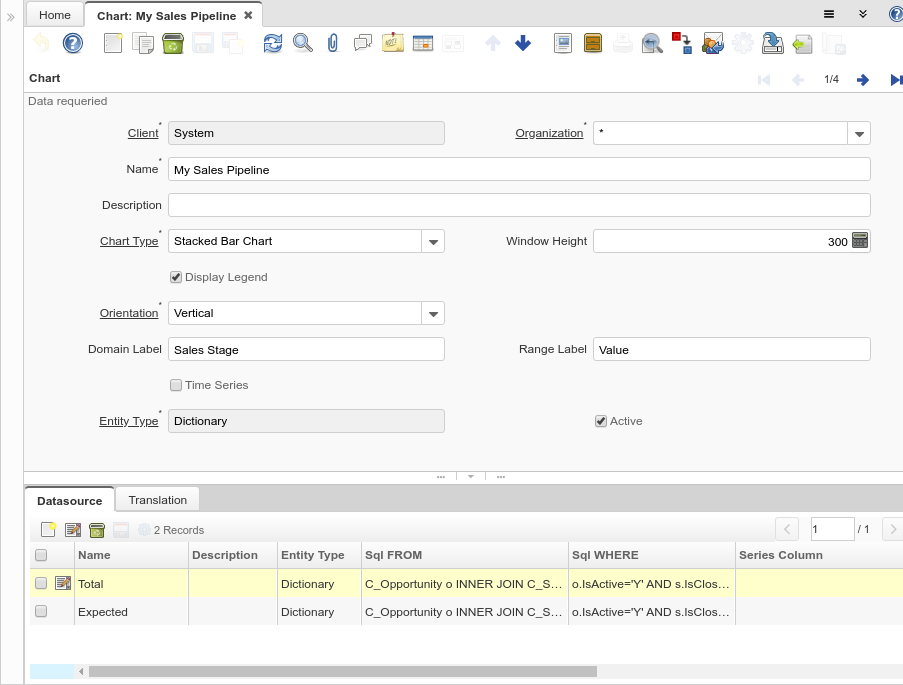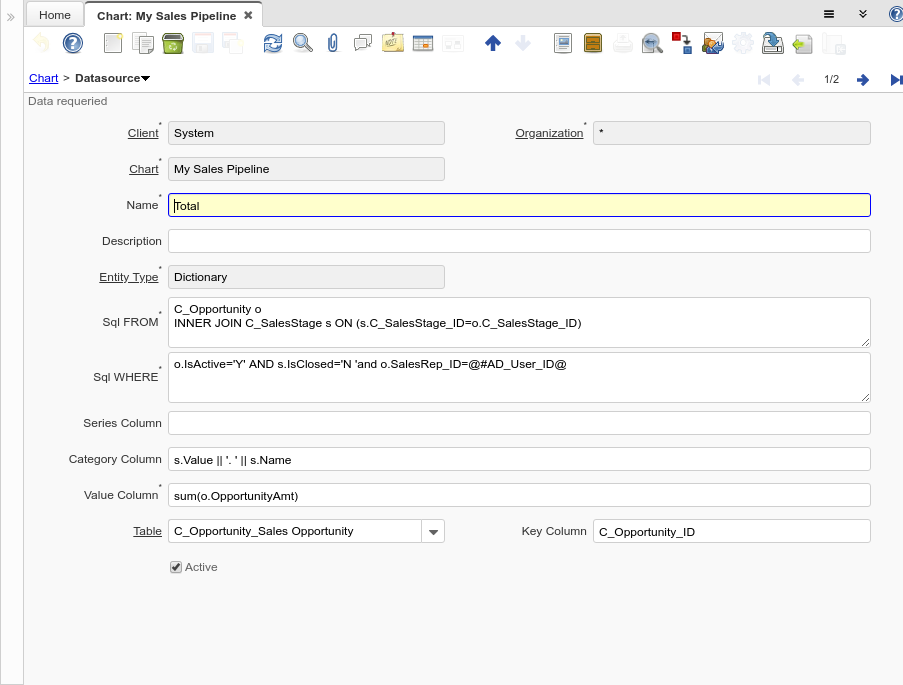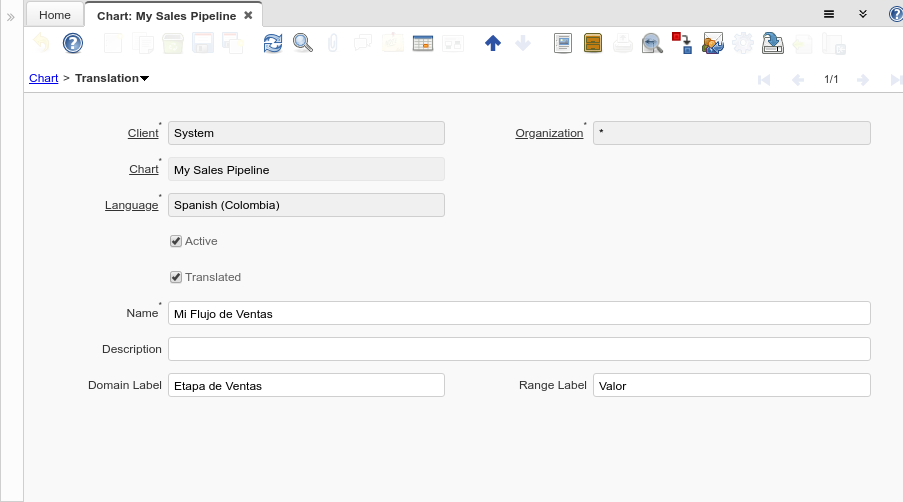Chart (Window ID-53124)
Window: Chart
Description: Chart Definition
Help:
Tab: Chart
Description:
Help:
| Name | Description | Help | Technical Data |
|---|---|---|---|
| Tenant | Tenant for this installation. | A Tenant is a company or a legal entity. You cannot share data between Tenants. | AD_Chart.AD_Client_ID numeric(10) Table Direct |
| Organization | Organizational entity within tenant | An organization is a unit of your tenant or legal entity - examples are store, department. You can share data between organizations. | AD_Chart.AD_Org_ID numeric(10) Table Direct |
| Name | Alphanumeric identifier of the entity | The name of an entity (record) is used as an default search option in addition to the search key. The name is up to 60 characters in length. | AD_Chart.Name character varying(60) String |
| Description | Optional short description of the record | A description is limited to 255 characters. | AD_Chart.Description character varying(255) String |
| Chart Type | Type of chart to render | AD_Chart.ChartType character varying(2) List | |
| Window Height | AD_Chart.WinHeight numeric(10) Integer | ||
| Display Legend | Display chart legend | Toggles the display of the chart legend | AD_Chart.IsDisplayLegend character(1) Yes-No |
| Orientation | The orientation of the chart. | AD_Chart.ChartOrientation character(1) List | |
| Domain Label | Label for the domain axis. | AD_Chart.DomainLabel character varying(60) String | |
| Range Label | Label for the range axis. | AD_Chart.RangeLabel character varying(60) String | |
| Time Series | The domain data for the chart is organised by time. | A time series chart will automatically group and restrict the data by the time unit and scope specified. | AD_Chart.IsTimeSeries character(1) Yes-No |
| Time Unit | The unit of time for grouping chart data. | AD_Chart.TimeUnit character(1) List | |
| Time Scope | The number of time units to include the chart result. | AD_Chart.TimeScope numeric(10) Integer | |
| Entity Type | Dictionary Entity Type; Determines ownership and synchronization | The Entity Types "Dictionary", "iDempiere" and "Application" might be automatically synchronized and customizations deleted or overwritten.
For customizations, copy the entity and select "User"! |
AD_Chart.EntityType character varying(40) Table |
| Active | The record is active in the system | There are two methods of making records unavailable in the system: One is to delete the record, the other is to de-activate the record. A de-activated record is not available for selection, but available for reports.
There are two reasons for de-activating and not deleting records: (1) The system requires the record for audit purposes. (2) The record is referenced by other records. E.g., you cannot delete a Business Partner, if there are invoices for this partner record existing. You de-activate the Business Partner and prevent that this record is used for future entries. |
AD_Chart.IsActive character(1) Yes-No |
Tab: Datasource
Description:
Help:
| Name | Description | Help | Technical Data |
|---|---|---|---|
| Tenant | Tenant for this installation. | A Tenant is a company or a legal entity. You cannot share data between Tenants. | AD_ChartDatasource.AD_Client_ID numeric(10) Table Direct |
| Organization | Organizational entity within tenant | An organization is a unit of your tenant or legal entity - examples are store, department. You can share data between organizations. | AD_ChartDatasource.AD_Org_ID numeric(10) Table Direct |
| Chart | AD_ChartDatasource.AD_Chart_ID numeric(10) Table Direct | ||
| Name | Alphanumeric identifier of the entity | The name of an entity (record) is used as an default search option in addition to the search key. The name is up to 60 characters in length. | AD_ChartDatasource.Name character varying(60) String |
| Description | Optional short description of the record | A description is limited to 255 characters. | AD_ChartDatasource.Description character varying(255) String |
| Entity Type | Dictionary Entity Type; Determines ownership and synchronization | The Entity Types "Dictionary", "iDempiere" and "Application" might be automatically synchronized and customizations deleted or overwritten.
For customizations, copy the entity and select "User"! |
AD_ChartDatasource.EntityType character varying(40) Table |
| Sql FROM | SQL FROM clause | The Select Clause indicates the SQL FROM clause to use for selecting the record for a measure calculation. It can have JOIN clauses. Do not include the FROM itself. | AD_ChartDatasource.FromClause character varying(2000) Text |
| Sql WHERE | Fully qualified SQL WHERE clause | The Where Clause indicates the SQL WHERE clause to use for record selection. The WHERE clause is added to the query. Fully qualified means "tablename.columnname". | AD_ChartDatasource.WhereClause character varying(2000) Text |
| Series Column | AD_ChartDatasource.SeriesColumn character varying(124) String | ||
| Category Column | Fully qualified data category column | The Category Column determines how the chart data is grouped | AD_ChartDatasource.CategoryColumn character varying(124) String |
| Date Column | Fully qualified date column | The Date Column indicates the date to be used when calculating this measurement | AD_ChartDatasource.DateColumn character varying(124) String |
| Time Offset | Number of time units to offset displayed chart data from the current date. | For example an offset of -12 with a chart time unit of Month will result in previous year data being displayed. | AD_ChartDatasource.TimeOffset numeric(10) Integer |
| Value Column | Fully qualified data value column | The Value Column contains the value data for the chart | AD_ChartDatasource.ValueColumn character varying(124) String |
| Table | Database Table information | The Database Table provides the information of the table definition | AD_ChartDatasource.AD_Table_ID numeric(10) Table Direct |
| Key Column | Key Column for Table | AD_ChartDatasource.KeyColumn character varying(124) String | |
| Active | The record is active in the system | There are two methods of making records unavailable in the system: One is to delete the record, the other is to de-activate the record. A de-activated record is not available for selection, but available for reports.
There are two reasons for de-activating and not deleting records: (1) The system requires the record for audit purposes. (2) The record is referenced by other records. E.g., you cannot delete a Business Partner, if there are invoices for this partner record existing. You de-activate the Business Partner and prevent that this record is used for future entries. |
AD_ChartDatasource.IsActive character(1) Yes-No |
Tab: Datasource Translation
Description:
Help:
File:Chart - Datasource Translation - Window (iDempiere 1.0.0).png
| Name | Description | Help | Technical Data |
|---|---|---|---|
| Tenant | Tenant for this installation. | A Tenant is a company or a legal entity. You cannot share data between Tenants. | AD_ChartDatasource_Trl.AD_Client_ID numeric(10) Table Direct |
| Organization | Organizational entity within tenant | An organization is a unit of your tenant or legal entity - examples are store, department. You can share data between organizations. | AD_ChartDatasource_Trl.AD_Org_ID numeric(10) Table Direct |
| Chart Datasource | AD_ChartDatasource_Trl.AD_ChartDatasource_ID numeric(10) Search | ||
| Language | Language for this entity | The Language identifies the language to use for display and formatting | AD_ChartDatasource_Trl.AD_Language character varying(6) Table |
| Name | Alphanumeric identifier of the entity | The name of an entity (record) is used as an default search option in addition to the search key. The name is up to 60 characters in length. | AD_ChartDatasource_Trl.Name character varying(60) String |
| Translated | This column is translated | The Translated checkbox indicates if this column is translated. | AD_ChartDatasource_Trl.IsTranslated character(1) Yes-No |
| Active | The record is active in the system | There are two methods of making records unavailable in the system: One is to delete the record, the other is to de-activate the record. A de-activated record is not available for selection, but available for reports.
There are two reasons for de-activating and not deleting records: (1) The system requires the record for audit purposes. (2) The record is referenced by other records. E.g., you cannot delete a Business Partner, if there are invoices for this partner record existing. You de-activate the Business Partner and prevent that this record is used for future entries. |
AD_ChartDatasource_Trl.IsActive character(1) Yes-No |
Tab: Translation
Description:
Help:
| Name | Description | Help | Technical Data |
|---|---|---|---|
| Tenant | Tenant for this installation. | A Tenant is a company or a legal entity. You cannot share data between Tenants. | AD_Chart_Trl.AD_Client_ID numeric(10) Table Direct |
| Organization | Organizational entity within tenant | An organization is a unit of your tenant or legal entity - examples are store, department. You can share data between organizations. | AD_Chart_Trl.AD_Org_ID numeric(10) Table Direct |
| Chart | AD_Chart_Trl.AD_Chart_ID numeric(10) Search | ||
| Language | Language for this entity | The Language identifies the language to use for display and formatting | AD_Chart_Trl.AD_Language character varying(6) Table |
| Active | The record is active in the system | There are two methods of making records unavailable in the system: One is to delete the record, the other is to de-activate the record. A de-activated record is not available for selection, but available for reports.
There are two reasons for de-activating and not deleting records: (1) The system requires the record for audit purposes. (2) The record is referenced by other records. E.g., you cannot delete a Business Partner, if there are invoices for this partner record existing. You de-activate the Business Partner and prevent that this record is used for future entries. |
AD_Chart_Trl.IsActive character(1) Yes-No |
| Translated | This column is translated | The Translated checkbox indicates if this column is translated. | AD_Chart_Trl.IsTranslated character(1) Yes-No |
| Name | Alphanumeric identifier of the entity | The name of an entity (record) is used as an default search option in addition to the search key. The name is up to 60 characters in length. | AD_Chart_Trl.Name character varying(60) String |
| Description | Optional short description of the record | A description is limited to 255 characters. | AD_Chart_Trl.Description character varying(255) String |
| Domain Label | Label for the domain axis. | AD_Chart_Trl.DomainLabel character varying(60) String | |
| Range Label | Label for the range axis. | AD_Chart_Trl.RangeLabel character varying(60) String |



